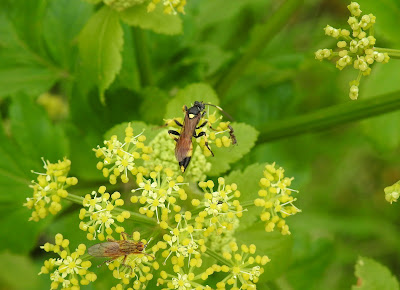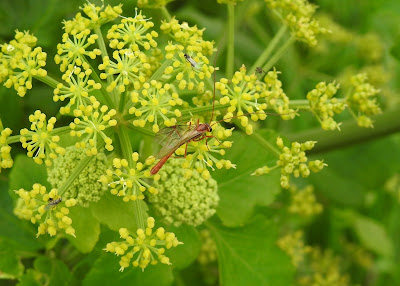Yesterday morning I headed to the coastal farm fields, for a bit of all round migration monitoring, or staring at the sea and the sky, drinking coffee, and seeing b*gger all, as is often the case! It was cold at first light, and the wind started off from the south-east, 10 - 15 mph, and moved round to a south-westerly direction.
With the exception of the Pink-footed Geese, the visible migration was very light, with low numbers, and few species involved. A weather front was heading north, with rain forecast to arrive between 0900 and 1000, so I suspect this was having a blocking effect, and preventing any birds moving from the south. My meagre totals were 14 Meadow Pipits, six Siskins and five Linnets.
The Pink-footed Geese movement was interesting, and it seemed that they were moving ahead of the forecast rain front. Birds were heading north out at sea, as well as directly over me on the coast. I counted 740 in total, with 249 of these birds at sea, and the other 491 directly over me.
It's a pity that the movement at sea could not be considered interesting, as it was very quiet...again! I had eight Common Scoters, six Gannets, three Eiders and three Whimbrel.
In one of the tidal pools directly opposite my vantage point, I enjoyed watching a Little Egret feeding. It would slowly walk through the water, spot something and either run, or spin round, perhaps holding a wing out to shade the water, then stab at its prey item with lightning speed. I hope you agree that the images I captured below, give you a flavour of this.
I decided to have a walk round the fields and hedgerows, before the rain came in, to look for any grounded migrants, but it was quiet. I had two male Wheatears on the sea wall, and then a male Stonechat and two Willow Warblers. My timing was perfect, as just a couple of minutes from my car, it started to rain heavily.
Stonechat
Late morning today, Gail and I decided to pay a visit to the Nature Park to see if any Sedge Warblers had arrived, and they had, with just one singing from some Willow scrub and reeds at the edge of one of the pools. From this same location, I had four Willow Warblers and a male Blackcap. So, two new species of summer migrant for us, for the year.
Singing Skylarks and Cetti's Warblers were the constant soundscape for the hour or so that we were there, and we had three and four respectively. Things have quietened down on the pools now with the Coots, Moorhens and Grebes on nests, but we did have 12 Coots, ten Tufted Ducks, three Moorhens and 11 Mallards.
A male Sparrowhawk drifted north whilst we were looking over the main pool, but whether it was a migrant or not, I'm not sure. We had two male Stonechats, or was that two sightings of the same male? They were virtually at either end of the site, and one was singing, and one wasn't. So, who knows?
We spent some time looking at the invertebrates on the Alexanders along the edge of the saltmarsh, and again there were some interesting species on the flowers. If we identified them correctly, we had two species of Ichneumon wasps; three Ichneumon stramentor and a single Ophion scutellaris. Both magnificent beasties. There were numerous other species of small flies, including at least six Yellow Dung Flies, one with prey, and we had a Tawny Mining Bee. All very common, but great to see and record.
Interestingly, there are 2,500 species of Ichneumon species in the UK, which is almost ten times our bee diversity. Many species visit flowers, particularly umbellifers, and they can therefore be quite significant pollinators of plant species in this group.
I had my first garden butterfly species of the spring this afternoon, when a Red Admiral whizzed through the garden, heading in a general northerly direction. I was sat in the garden hoping for a raptor or two over, but it wasn't to be.
I read with sadness that the deadly Highly Pathogenic Avian Influenza (HPAI) that has been decimating sea-bird populations, has now been confirmed in mammals in the subantarctic. The disease was detected in January 2024 in Southern Elephant Seals and Antarctic Fur Seals in South Georgia.
Scientists in this subantarctic region have been testing for bird flu in mammals since cases were first recorded there following the deaths of several Brown Skuas in October 2023. Analysis from infected birds demonstrates that the virus has most likely been introduced through migratory birds from South America. A very sad state of affairs.













No comments:
Post a Comment